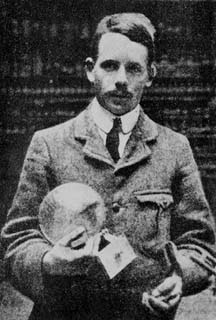
Cathode rays
In 1855 Heinrich Geissler, a glass blower
from Bonn, invented the mercury vapor vacuum pump to remove air
from a space. Soon thereafter, scientists began probing the properties
of evacuated space. Of particular interest was the discovery that
evacuated space in a Geissler tube could conduct electricity.
Over the next forty years, physicists in Europe compiled a list
of interesting phenomena. Some of this work is described here.
See a brief history at http://www.aip.org/history/electron/jjrays.htm#geissler
and http://dbhs.wvusd.k12.ca.us/webdocs/AtomicStructure/AtomicStructure.html
| Mod-03 |
Here is an illustrated piece about
:Sir William Crookes The Electron Centennial Page addresses
these topics: |
J.J. Thomson and the Discovery of the Electron
Are cathode rays charged particles or are they part of the electromagnetic spectrum? By 1895, these were the properties that cathode rays exhibited:
1) cathode rays cast shadows (read: they travel in straight lines)
2) cathode rays cause certain chemical reactions to occur (they caused photo emulsions to decompose.)
3) Any metal cathode could produce cathode rays. (likely to be a universal property of matter)
4) Cathode rays are deflected by an electric field (repelled by the negative plate)
5) Cathode rays are deflected by a magnetic field
 |
If cathode rays were charged particles, what was the size of the charge and, for that matter, what was the mass of the particle? The keystone experiment in this long line of research was done by (Sir Joseph John) J.J. Thomson in England in 1897. Try as he would, he could not determine either the charge or the mass , one independent of the other. The best he could produce was e/m, the charge to mass ratio for cathode rays particles. He determined e/m to be 1.76 x 10^11 Coulombs/kilogram. By itself, this number has little meaning. Thompson needed something by which he could compare e/m. he measured q/m, the charge (e stands for the charge on the electron, q , the charge on everything else) to mass ratio for hydrogen ions, heretofore the smallest particle on the planet |
. He found
|
|
Thomson pursued this line of reasoning regarding this equation: If e = q,then
| m (H+ ion) = 1846 m (CR particles) |
The results of his experiments, coupled with some bold conjecture, lead to the conclusion that atoms have constituent parts
 |
Henry Moseley and the discovery of the proton From the time of Mendeleev, the order
of the elements had been determined mostly by increasing atomic
mass. It was the work of Harry (Henry Gwyn-Jefferies) Moseley
in the analysis of the lines in the X-ray spectra of the elements
that came the suggestion that atomic number, the place of an
element on the periodic table, was more important than atomic
weight. One does not know much about Moseley. Born in 1887, he
died at Gallipoli in 1915, shot by a sniper http://www.phys.virginia.edu/classes/252/Bohr_to_Waves/Bohr_to_Waves.html |
|
http://www.dpgraph.com/janine/twins.html The Atomic Number Puzzle |
http://www.dpgraph.com/janine/partons.html Particles from the Sky The Big Machines The Particle Zoo The Eightfold Way Probing the Proton The Plum Pudding Proton Bibliography |